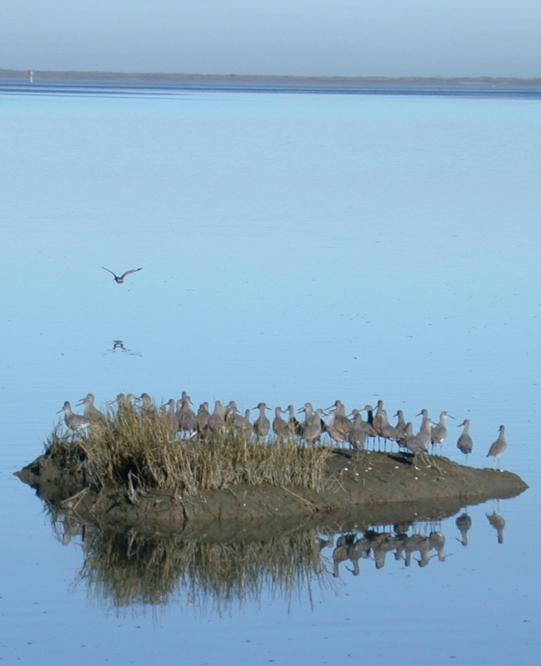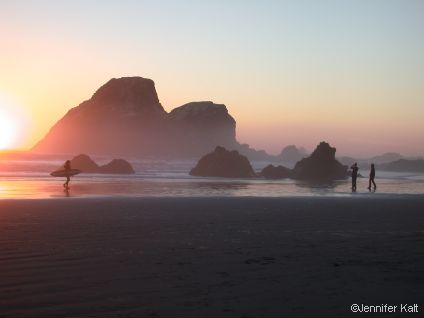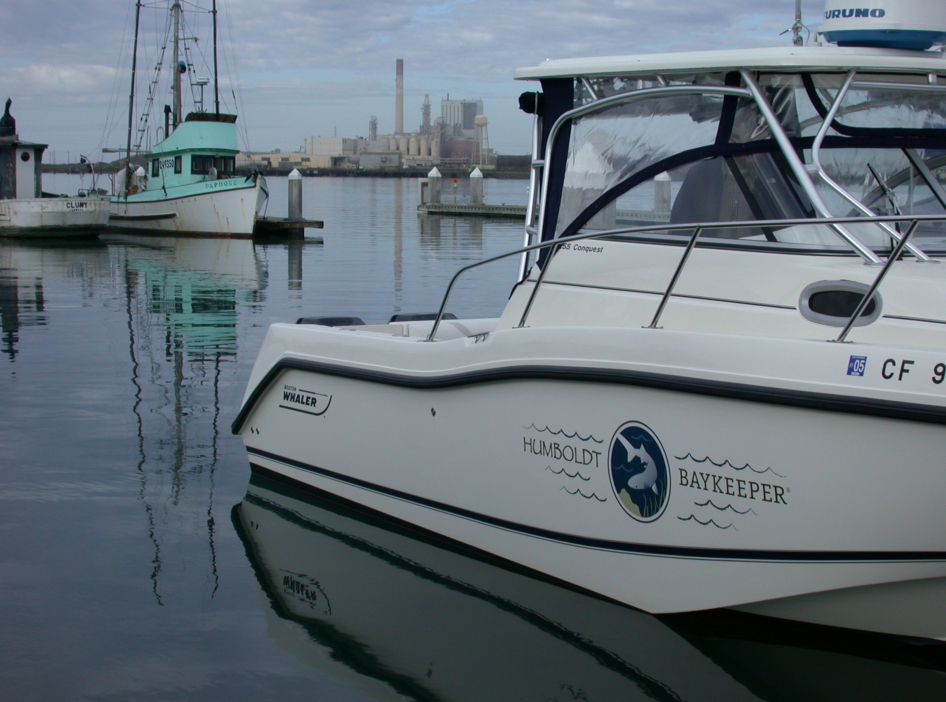Our annual report highlights Humboldt Baykeeper's successes over the past year.
Click on the Table of Contents on the right to read a section of the report. To download the Annual Report 2011 in its entirety, click HERE.
For the last 7 years, Humboldt Baykeeper has been working to act as your voice for Humboldt Bay and the coast. Our goal is to protect not only the quality of our water around the Bay, but also our quality of life on the North Coast. Reflecting on our work in 2011 provides insight into 2012 and the challenges ahead, and we need your help!
Please renew your membership, or become a new member, of Humboldt Baykeeper today, and invest in a healthy future for our Humboldt Bay community. Your contribution of $25 or more provides needed funds to fight pollution, monitor the quality of our waters, and educate the community about the Bay and our coastal waters. And remember, every contribution is fully tax-deductible
Stop by our office at 217 E St. in Old Town Eureka, give us a call at (707)268.8897 for more information!
Thank you for joining our effort to safeguard Humboldt Bay and our coast. Here’s to another great year!
FROM THE DIRECTOR
During these economically and politically tumultuous times, it is more crucial than ever to protect our right to swimmable, drinkable and fishable waters as Congress attacks the Clean Water Act and works to deregulate industry in the name of job creation. Humboldt Baykeeper knows a clean environment is imperative for healthy communities, our economy, and our quality of life and we will continue to safeguard our Bay and coast!
Living on the North Coast is a blessing and Humboldt Baykeeper is working hard to be your voice for clean water. We continue to watchdog projects around Humboldt Bay to make sure that any development is accompanied with proper sampling to protect the Bay from toxics. Our efforts to abate the impacts of dioxin contamination around Humboldt Bay are making a difference and we will continue to protect the environment from the toxic legacy of the industrial timber era.
Humboldt Baykeeper continues to act as a strong advocate for the Humboldt Bay community and the coast. In the past year we have maintained our role as the watchdog regarding Bay and coastal issues from Trinidad Head to the mouth of the Eel River.
At a time when government resources are stretched thin and decision-makers are being led astray by big business lobbyists, Humboldt Baykeeper will continue to represent you and work to protect our natural resources. I thank you for your continued support and look forward to working for you in 2012. There is much work to be done, and we are excited for 2012 - onward and upward!

Beth Werner, Executive Director

FIGHTING TOXIC POLLUTION
Since our inception, Humboldt Baykeeper has been conducting an extensive review of the industrial sites that may be point sources of dioxin contamination around the Bay. An ongoing part of this process is the development of strategies to address the sites most in need of remediation.
Over the past year, Humboldt Baykeeper has continued to monitor the results of the cleanup that was completed at Simpson Timber Company’s bayside mill in Eureka as a result of our 2008 settlement agreement. Sampling at the site shows continuing success of the remediation work in the tidal channel adjacent to the property, which has eliminated discharges from the site into Humboldt Bay.
In September of 2010, Humboldt Baykeeper achieved a successful settlement agreement in its litigation regarding numerous violations of the Clean Water Act at Union Pacific’s former rail yards at the Balloon Track along the Eureka waterfront. For decades, this site has been releasing dioxin and other toxins into Humboldt Bay and after four years of litigation, Humboldt Baykeeper reached an agreement with the current and past landowners that will result in the elimination of numerous hot-spots on the property. Humboldt Baykeeper continues to watchdog the implementation of the cleanup plan that was developed as a result of the settlement, which will reduce pollution discharges to Humboldt Bay.
In both settlement agreements, Humboldt Baykeeper’s ongoing oversight provides the key component in ensuring that any legal action we are part of truly results in on-the-ground benefits to our environment and our community.
More recently, Humboldt Baykeeper has begun to integrate the information developed through our site investigations with our Climate Change Adaptation Program. Through this approach, Humboldt Baykeeper will be prioritizing contaminated properties most at risk of flooding and erosion from projected sea level rise.

DIOXIN ADVOCACY
Humboldt Baykeeper continues to watchdog projects and proposals around the Bay to bring contamination issues to the forefront and ensure that dioxin review is integrated into all project approvals and planning processes. This advocacy work prevents backsliding on the strides we have made to develop broad-based awareness and understanding of the contamination issues that impact Humboldt Bay.
Over the past year Humboldt Baykeeper has advocated for dioxin analysis in all projects that involve the disturbance of Humboldt Bay sediments. Despite the fact that in 2006 we successfully petitioned the State Water Resources Control Board to list Humboldt Bay as Impaired by dioxin on the Clean Water Act Section 303(d) list, project proponents continue to hope that they will be able to slip their projects through without the necessary analysis. Humboldt Baykeeper regularly rejects this perspective.
Humboldt Baykeeper recently convinced the Harbor District to require dioxin analysis and appropriate disposal for excavated sediments at a metal salvage yard located on Humboldt Bay (G&R Metals). Historical activities on the property included metals reclamation from transformers, automobile dismantling and wrecking, storage of batteries, radiators, etc. These uses resulted in contamination of both an upland and a tidal portion of the property with PCBs (polychlorinated biphenyls), metals, and PAHs (polycyclic aromatic hydrocarbons). Humboldt Baykeeper was aware of sampling in the tidal mud flat portion of the property that showed elevated levels of dioxin, and was also able to use this information to convince the District to require additional sampling for dioxin.
Humboldt Baykeeper will continue to watchdog Bay-related development proposals in the year ahead. Despite the fact that the sediments of Humboldt Bay are contaminated with various chemicals, including dioxin, there is an ongoing need for the dredging of Bay sediments for economic activities associated with fishing and aquaculture. We will continue to work to ensure that our community and our environment are protected from the legacies of past industrial activities on and around Humboldt Bay. As we move into 2012, Humboldt Baykeeper is working with local agencies to help develop an acceptable plan for the beneficial reuse of the dredged materials for wetlands restoration work while prohibiting environmental exposure to dioxin.

CLIMATE CHANGE ADAPTATION
Climate change around Humboldt Bay is a serious threat and Humboldt Baykeeper is working to ensure that our sensitive coastal resources are protected from the effect of sea level rise. Humboldt Baykeeper has been advocating for policies to adapt to sea level rise in both planning policies and in specific project proposals. Adaptation to sea level rise will require that residential development and public infrastructure such as roads, wastewater treatment and power plants consider projected sea level rise and plan accordingly to avoid creating new problems related to flooding, erosion, and storm damage in low-lying coastal areas.
Existing infrastructure and residential/commercial developments will need to be protected from sea level rise. Future levee expansion and armoring must also consider how best to protect coastal wetlands to mitigate the impacts of rising sea levels on these important habitats and the species they support.
Humboldt Baykeeper has been an active participant in the Humboldt Bay Initiative since its inception. This consortium of resource managers, scientists, and community members works to address management issues across disciplines linking science and policy issues for the entire ecosystem. Currently, the Humboldt Bay Initiative’s Climate Change Adaptation Project is developing a model in conjunction with Nature Serve’s Ecosystem-Based Management (EBM) Tools Network to predict wetland migration and sea level rise. This model will be used to initiate a coordinated response to climate change in the Humboldt Bay area as sea level rises. Humboldt Baykeeper has contributed to the prioritization of strategies to adapt to climate change as the need for levee expansion limits the ability of coastal wetlands to migrate inland, and will continue our advocacy work to ensure that protection of coastal resources is considered in climate adaptation plans and coastal projects.

In August 2010, Humboldt Baykeeper used its 5 years of Citizen Monitoring data as the basis for recommending that the Regional Water Quality Control Board list six streams as impaired under the Clean Water Act due to extremely high levels of the pathogenic bacteria, E. coli. In addition, high fecal coliform levels have resulted in temporary closures of several local beaches by Humboldt County’s Ocean Monitoring Program. Humboldt Baykeeper’s Citizen Monitoring Program is the only source of water quality data upstream from these beaches. Though we are still awaiting the Regional Board’s decision, the listing could result in better land use policies and funding for projects to reduce polluted runoff to these streams, which ultimately flows into Humboldt Bay and the ocean, putting residents and the oyster industry at risk.
In 2012, we hope to begin a project correlating our water monitoring results with field assessments to prioritize on-the-ground projects that can best improve water quality by reducing impervious surfaces, improve stormwater infiltration, and increase riparian vegetation to filter polluted runoff.

Recognizing that the North Coast is a unique region, Humboldt Baykeeper continues to ask the Fish and Game Commission to rely on the contributions made by tribes and tribal communities, recreational and commercial fishermen, conservationists, and recreational coastal users as they finalize our marine protected areas. Developing a robust marine reserve network that is ecologically vibrant, maintains the strong fishing industry that is at the center of North Coast culture and respects traditional non-commercial tribal harvest is of the utmost importance for Humboldt Baykeeper. The FGC will be finalizing the North Coast’s marine protected area network in 2012, and Humboldt Baykeeper will be at the forefront of the process.
Humboldt Baykeeper is dedicated to public participation and will work to keep the public informed of the progress made as the MLPA process moves forward through regular presentations and outreach.

RESTORING URBAN CREEKS
In 2009, Humboldt Baykeeper initiated an internship program in conjunction with Dr. Alison Purcell O’Dowd, Assistant Professor and Environmental Science Program Coordinator at Humboldt State University. Humboldt Baykeeper provides sampling equipment and guidance to student interns enrolled in Applied Ecological Restoration (ENVS 450) who study riparian and instream conditions in Widow White Creek, a tributary of the Lower Mad River in McKinleyville.
Baykeeper Interns collect data on benthic macroinvertebrates, turbidity, pebble counts and embeddedness surveys, bank stability, and other indicators of watershed health. Widow White Creek’s health has been negatively impacted as a result of the urbanization of 25% of its lower watershed, as well as logging and low-density residential development in its upper watershed. The creek historically supported coho salmon, steelhead trout, cutthroat trout, three-spine stickleback, and sculpins, and is an important target for restoration.
As McKinleyville has developed, the increase in impervious surfaces from pavement and rooftops has increased peak flows during storm events, causing erosion and bank destabilization in lower Widow White Creek. With three years of data, it is increasingly clear that the restoration activities undertaken by Redwood Community Action Agency in the lower reach of the creek have had a positive effect on instream conditions, pointing to the need for such restoration work further upstream, where aquatic habitat conditions remain poor.

ADVOCATING FOR RESPONSIBLE DEVELOPMENT
Humboldt Baykeeper monitors development proposals, land use planning, and permitting agencies to ensure compliance with environmental laws and the highest level of protection for the environment, with an emphasis on toxics from past industrial uses, water resources, riparian areas and wetlands, and salmon habitat that is critical for rearing and spawning.
In the past year, we advocated for responsible coastal development by reviewing and commenting on the Samoa Town Project, as well as the City of Arcata’s Local Coastal Program - the land use plan that governs development in coastal areas of the City. Additionally, we are currently involved in litigation with the City of Eureka regarding violations of the California Environmental Quality Act (CEQA) on the Marina Center Environmental Impact Report. This litigation is currently on hold due to its review by the California Coastal Commission as a result of our advocacy efforts in that forum.
As a member of the Healthy Humboldt Coalition, reviewing and commenting on the County’s General Plan Update has been a major focus for several years. This year, we were successful in advocating for better policies to protect water resources, including expanded riparian and wetland buffers, oversight of water withdrawals from salmon-bearing streams, and increased protections for open space. Once adopted, these policies will provide greater protections for salmon habitat and water quality. We will continue to watchdog the General Plan Update through its next steps as the process of developing ordinances to implement these new and improved policies moves forward.

The Humboldt Bay Exploration Tours, our most successful community project, is a great example of Baykeeper volunteers in action. Every year, from Godwit Days through October, Humboldt Baykeeper brings hundreds of community members aboard our 28 ft Boston Whaler to share the natural history of Humboldt Bay. In 2011, the Bay Exploration tours connected more than 450 people from all walks of life to the Bay through wildlife sightings, up-close views of eel grass beds and salty spray. For many, Humboldt Baykeeper provides the first, and often only, boating experience that local residents have. Bay Exploration tours run every weekend, guided by trained volunteer skippers and docents who have deep knowledge and passion for Humboldt Bay. The tours are an opportunity to share that passion with the public.
Dedicated volunteers also provide the work force for several annual beach and estuary clean-ups. 2011 saw the removal of hundreds of pounds of garbage from Liscom Slough to the Samoa Bridges. On July 5th, a crew of Humboldt Baykeeper volunteers cleaned up post-Independence Day festivities on Mad River Beach picking up debris from exploded fireworks, cellophane wrappers, broken glass and nails. Two longtime volunteers, Pam and Ted Halstead, have adopted Liscom Slough in the Arcata Bottoms as their primary clean-up site. To date, they have removed car parts, televisions, household chemicals and pretty much everything imaginable from this important aquatic habitat.
Humboldt Baykeeper also maintains an Adopt-a-Highway stretch on the Samoa Bridges crossing over the Bay. Throughout the year, volunteers head out on Saturday mornings to intercept the great trash migration from our roadsides into the Bay and ultimately the ocean. 2012 marks an expansion in this clean-up effort as we begin to tally the number of plastic bags found in this critical two-mile stretch.
The day-to-day operations are critical to keeping Humboldt Baykeeper running. A special thank you to the volunteers who stop by our office to stuff envelopes, write letters, run errands, and generally cheer us up. Thank you to all of our wonderful volunteers who work so hard for a better community and environment - we couldn’t do it without you!

In 2011, Humboldt Baykeeper and the California Coastkeeper Alliance worked hard to garner support for Assembly Bill 376, a bill making it unlawful for any person to possess, sell, trade, or distribute shark fins. The California state legislature passed this much-needed bill in the fall after vigorous debate, adding California to the list of Pacific states including Oregon, Washington, and Hawaii, to ban the sale of shark fins.
The California Coastkeeper Alliance also worked to support Assembly Bill 1112, a bill ensuring that California can maintain its existing ability to prevent and clean up costly oil spills through the Oil Spill Response and Prevention Fund. Currently, the Fund comes from a 5-cent fee paid by oil companies on each barrel of crude oil delivered into California - a fee that has not increased since 2002, when the rate increased one penny. The California state legislature passed this bill, increasing fees to six and three-quarters cents per barrel. These fees will bring in much needed resources to the Fund to protect California’s coastal ecosystem.
Looking ahead, Humboldt Baykeeper is working locally to enact a countywide ban on single-use plastic bags. The state legislature failed to pass a statewide ban in 2010 due to heavy lobbying by the American Chemistry Council, the lobbying group representing the plastic bag industry. We are working with the Surfrider Humboldt Chapter to garner support for banning single-use plastic bags within the county, and will be looking to the Humboldt Waste Management Authority to move the ordinance forward in 2012.




